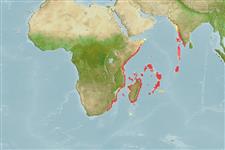Environment: milieu / climate zone / depth range / distribution range
นิเวศวิทยา
เกี่ยวกับทะเล,น้ำเค็ม สัตว์น้ำหน้าดิน; ระดับความลึก 40 - 507 m (Ref. 86966). Subtropical
Western Indian Ocean: South Africa, Madagascar, the Seychelles and Réunion.
ขนาด / น้ำหนัก / Age
Maturity: Lm ? range ? - ? cm
Max length : 21.6 cm SL เพศผู้/กระเทย; (Ref. 86966)
Short description
สัณฐานวิทยา | ความยาวต่างๆ
เงี่ยงครีบหลัง (รวม): 12; ก้านครีบอ่อนที่หาง (รวม): 9-11; เงี่ยงครีบก้น 3; ก้านครีบอ่อนที่ก้น: 5; สัตว์มีกระดูกสันหลัง: 26. This species is characterized by the following: D XII, 9-11 (usually 10); A III,5; pelvic-fin rays I,5; pectoral-fin rays 18 on each side of body (asymmetrically 17 and 18 in one specimen); Longitudinal scale series 32-37; pored lateral-line scales 23-25 (usually 25); scale rows above lateral line 4-5 (usually 5) and below 10; scale rows between last dorsal-fin spine base and lateral line 4-5 (usually 5); 6 scale rows between sixth dorsal-fin spine base and lateral line; 6-8 predorsal scales; gill rakers on upper limb 5-7, lower limb 12-13, total 17-20 (usually 18); 26 vertebrae (based on MNHN 2003-291); head length 45.9-48.6% of SL; orbit diameter 12.0-17.1% of SL (value significantly decreasing with growth); interorbital width at middle of eye 4.4-5.8% of SL; lateral lacrimal spine absent; anterior lacrimal spine rounded, not spinous shape; posterior lacrimal spine triangular; suborbital spines 4-8; preopercular spines 5, with an additional spine on uppermost spine; preocular, supraocular, postocular, and tympanic spines are well developed; interorbital ridges joined posteriorly to tympanic spine bases; no parietal spine; the large and well developed nuchal spine originating from posterior end of tympanic spine; absence of interorbital, coronal and pretympanic spines; occiput nearly flat, without pit; sphenotic spines 2-13; parietal, lower posttemporal and supracleithral spines well developed; no upper posttemporal spine, but a small spine occurring between nuchal and lower posttemporal spines; posterior margin of maxilla just short of or reaching a vertical through posterior margin of orbit; with teeth on vormer and palatines; pectoral fin bilobed; usually a large black blotch on dorsal fin basally between fifth-seventh and tenth spines (lacking the blotch in some specimens); body is strongly mottled, especially dorsally (Ref. 86966).
Life cycle and mating behavior
วัยเจริญพันธุ์ | การสืบพันธุ์ | การวางไข่ | เซลสืบพันธ์ของเพศเมีย(ไข่) | ความดกของไข่ | ตัวอ่อน
Motomura, H., P. Béarez and R. Causse, 2011. Review of Indo-Pacific specimens of the subfamily Scorpaeninae (Scorpaenidae), deposited in the Muséum national d’Histoire naturelle, Paris, with description of a new species of Neomerinthe. Cybium 35(1):55-73. (Ref. 86966)
IUCN Red List Status (Ref. 130435)
Threat to humans
Harmless
Human uses
ข้อมูลเพิ่มเติม
ชื่อสามัญชื่อพ้องกลไกการเผาผลาญพลังงานผู้ล่าการศึกษาเกี่ยวกับผลกระทบของสารประกอบทางเคมีที่เป็นอันตรายต่อสิ่งมีชีวิต ประชากร และสิ่งแวดล้อมการสืบพันธุ์วัยเจริญพันธุ์การวางไข่การรวมกลุ่มวางไข่ความดกของไข่เซลสืบพันธ์ของเพศเมีย(ไข่)Egg development
Age/SizeการเจริญเติบโตLength-weightLength-lengthLength-frequenciesความยาวต่างๆสัณฐานวิทยาตัวอ่อนพลวัตของสัตว์น้ำวัยอ่อนการทดแทนที่อุดมสมบรูณ์BRUVS
อ้างอิงการเพาะเลี้ยงสัตว์น้ำประวัติการเพาะเลี้ยงสัตว์น้ำสายพันธุ์พันธุศาสตร์ElectrophoresesอัตราพันธุกรรมโรคการแปรรูปNutrientsMass conversion
ผู้ร่วมมือรูปภาพหลายรูปStamps, Coins Misc.เสียงปลามีพิษ เช่น ปลาปักเป้าความเร็วรูปแบบการว่ายน้ำพื้นที่เหงือกOtolithsสมองวิสัยทัศน์
เครื่องมือ
Special reports
Download XML
แหล่งที่มาจากอินเตอร์เน็ต
Estimates based on models
Preferred temperature (Ref.
123201): 15.3 - 17.9, mean 16.8 °C (based on 4 cells).
Phylogenetic diversity index (Ref.
82804): PD
50 = 1.0000 [Uniqueness, from 0.5 = low to 2.0 = high].
Bayesian length-weight: a=0.01259 (0.00606 - 0.02615), b=3.03 (2.86 - 3.20), in cm total length, based on LWR estimates for this (Sub)family-body shape (Ref.
93245).
ระดับชั้นอาหาร (Ref.
69278): 3.9 ±0.6 se; based on size and trophs of closest relatives
ความสามารถในการกลับคืนสู่ปกติ (Ref.
120179): ขนาดกลาง, เวลาต่ำสุดที่จะทำให้ประชากรเพิ่มขึ้นเป็น 2 เท่าใช้เวลา 1.4 - 4.4 ปี (Preliminary K or Fecundity.).
Fishing Vulnerability (Ref.
59153): Low vulnerability (16 of 100).
